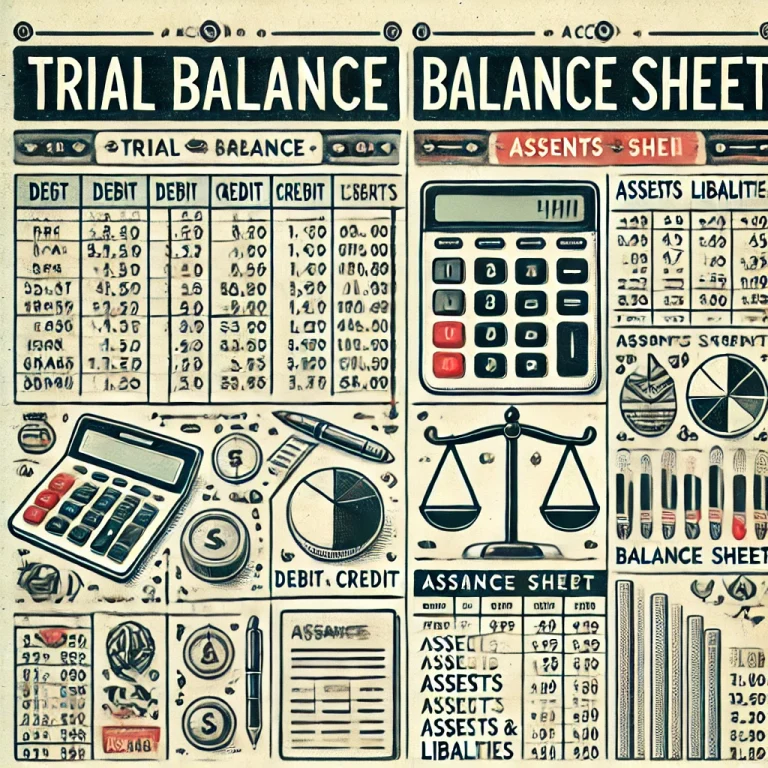One of the things that often confuses the beginner in accounting is the difference between a trial balance and a balance sheet. The two financial statements have different purposes and provide different kinds of insights into a business’s financial health. Where a trial balance is merely a list of all ledger balances for internal verification, the balance sheet represents the final financial position of the company at the end of an accounting period.
Trial Balance vs Balance Sheet: Key Differences
Both the trial balance and the balance sheet are the primary tools used in accounting and finance analysis. A trial balance is used in a pre-check format and lists down all ledger accounts to show that the total debits equal the total credits. The balance sheet, meanwhile, acts as a final summary of how well the company’s business is by showing assets, liabilities, and owner’s equity. Here is the comparative review:
| Aspect | Trial Balance | Balance Sheet |
|---|---|---|
| Purpose | Internal accuracy check | Shows financial position |
| Content | Ledger balances | Assets, liabilities, and equity |
| Time | Prepared anytime, typically monthly | Prepared at the end of an accounting period |
| Legal Requirement | Not mandatory | Mandatory for most entities |
| Presentation Format | Simple list of balances | Structured under assets, liabilities, and equity |
What is Trial Balance?
This process of preparing a trial balance is essentially an internal finance document indicating that all the transactions in the accounting ledgers have been properly recorded. Its chief importance is to ensure that the summation of debit accounts in the account books is equal to the summation of credit accounts, making it sound in the process of the double-entry system of accounting. Accountants take some time to prepare a trial balance, mainly on a monthly or quarterly basis, early enough to be able to detect some discrepancies and allow for error correction.
Features of Trial Balance
- Lists Ledger Balances: Shows both debit and credit balances from the general ledger.
- Internal Use: Used to detect errors before preparing the balance sheet.
- Simple Format: A straightforward listing of balances.
- Not Legally Required: Unlike the balance sheet, a trial balance is not required for regulatory filings.
What is the Balance Sheet?
A balance sheet is a statement of the position of a company at a point in time. It represents an aggregation of assets, liabilities, and shareholders’ equity, showing what the business owns and owes. A balance sheet is a statutory requirement for public companies, and it forms part of the financial statements of companies.
Features of Balance Sheet
- Shows Financial Position: Provides a snapshot of financial stability.
- Assets, Liabilities, and Equity: Organized into sections for assets, liabilities, and shareholders’ equity.
- Legally Required: Essential for regulatory compliance and financial reporting.
- Helps Stakeholders: Useful for investors, creditors, and management for decision-making.
Key Differences Between Trial Balance and Balance Sheet
The key differences between trial balance and balance sheet lie in their purpose, format, and content. Here’s a deeper look at their distinctions:
Purpose and Functionality
- Trial Balance: Primarily an internal document, it is used by accountants to ensure that ledger entries balance. If discrepancies exist, it alerts accountants to errors in the ledger.
- Balance Sheet: A formal document that provides a financial summary to external stakeholders. It communicates a company’s financial health to investors, creditors, and other interested parties.
Content Structure
- Trial Balance: Lists all general ledger accounts with their respective debit or credit balances.
- Balance Sheet: Summarizes assets, liabilities, and equity, organized in a way that shows the company’s net worth at the end of an accounting period.
Format and Complexity
- Trial Balance: Presented in a straightforward table format with two columns (debit and credit).
- Balance Sheet: Typically structured with multiple sections (assets, liabilities, and equity), often including detailed subcategories.
Frequency and Timing
- Trial Balance: This can be prepared as needed (e.g., monthly) to check accuracy before preparing the final statements.
- Balance Sheet: Prepared at the end of an accounting period, like quarterly or annually, as part of official financial statements.
How to Generate Trial Balance and Balance Sheet Easily?
Use intelligent business accounting software and eliminate pains in the generation of your trial balance and balance sheet. It makes balancing very easy and also assists efficiently in auditing your transactions in such a manner that these become both quick and fast.
Generating a Trial Balance
Step 1: Ledger Balances – Collect all the ledger balances for each account.
Step 2: Enter Balances – List each account under debit or credit columns based on its balance.
Step 3: Verify Totals – Add the debit and credit columns to ensure they balance. If not, identify and correct discrepancies.
Generating a Balance Sheet
Step 1: Organize Data – Gather totals for all assets, liabilities, and equity accounts.
Step 2: Format Data – Divide data into assets, liabilities, and equity sections.
Step 3: Double-Check – Ensure assets equal the sum of liabilities and equity, following the accounting equation: Assets = Liabilities + Equity.
Step 4: Presentation – Prepare the balance sheet in a clean, structured format for stakeholders.
Conclusion
Therefore, a distinction should be identified between the trial balance and the balance sheet due to carrying crucial importance to prepare appropriate financial analysis. A check that should ensure the accuracy, as well as completeness of all entries, comes through the medium of this trial balance. Whereas with a balance sheet, for the external party, the proper financial summary would be furnished. Both documents go parallel in maintaining accuracy for business organizations at their accountable stages.
Trial Balance and Balance Sheet FAQs
What is the purpose of a trial balance?
A trial balance is primarily used to verify that all ledger entries are balanced, ensuring the accuracy of accounting records before preparing the balance sheet.
Why is the balance sheet important?
The balance sheet provides a snapshot of a company’s financial position, helping stakeholders assess the company’s assets, liabilities, and overall net worth.
Is a trial balance legally required?
No, a trial balance is not legally required, but it is a valuable tool for internal verification.
Can a trial balance show financial health?
Not entirely; while it ensures entry accuracy, it does not provide the complete financial position of a business as the balance sheet does.
How often are trial balances prepared?
They can be prepared as often as needed, typically monthly or quarterly, to ensure the ledger’s accuracy before final statements are made.


